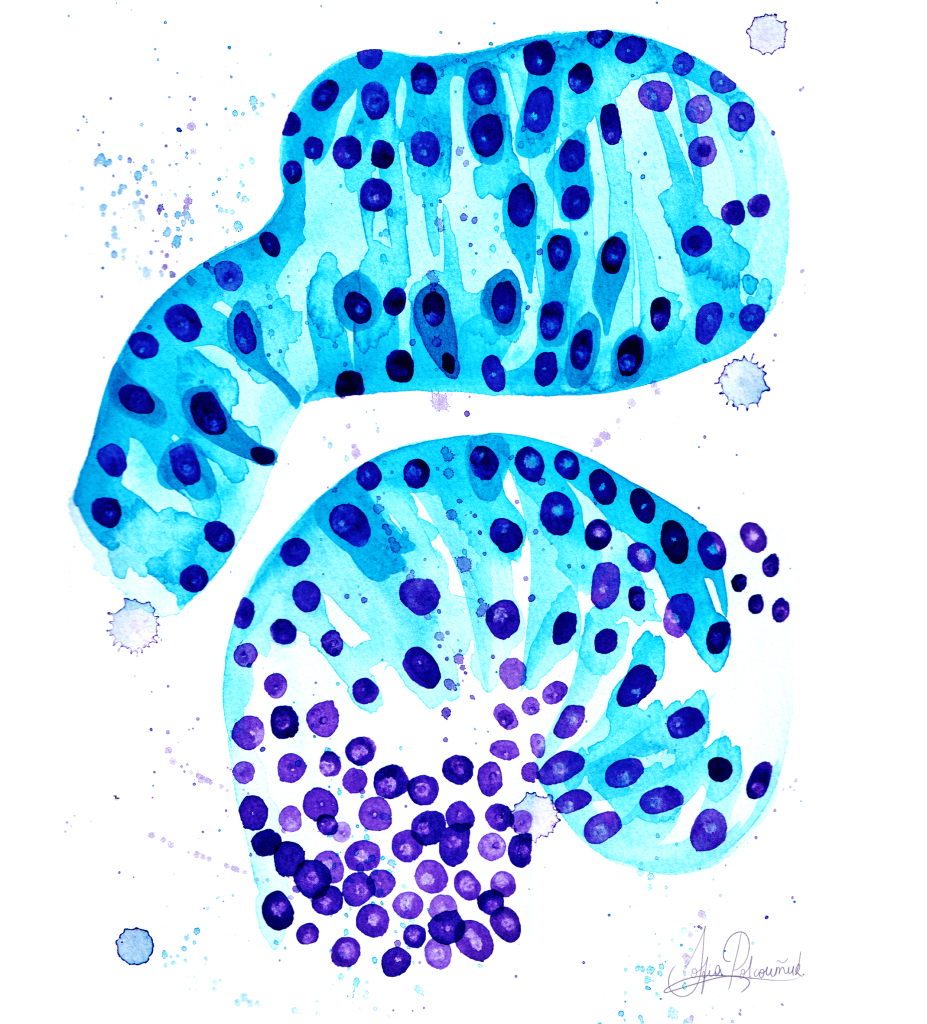Name: Diego Araujo Which came first in your life, the science or the art? Is there a difference between them (laugh)? As far as I ...Thank you for reading, please visit Art the Science's Blog for more amazing SciArt...
Name: Diego Araujo
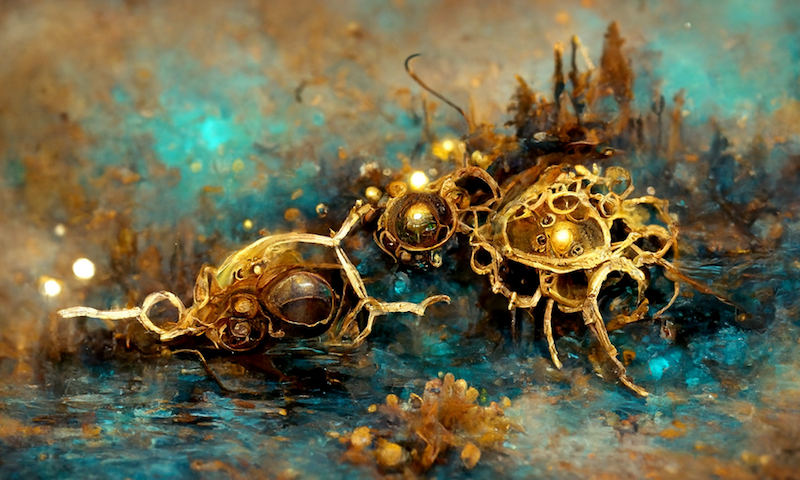 Aquatic life forms in a pond (2022). From “The Natural History of the Aetherworld”. AI illustration generated in Disco Diffusion by Diego Araujo.
Aquatic life forms in a pond (2022). From “The Natural History of the Aetherworld”. AI illustration generated in Disco Diffusion by Diego Araujo.
Which came first in your life, the science or the art?
Is there a difference between them (laugh)? As far as I can remember, as a young kid, I was already doing some sort of drawing, but I was also admiring the drawings of Amoeba and spiders in biomedical encyclopedias we had at home. Formally, I developed myself as a scientist. That meant going through a BSc in Biology, MSc in Ecology, and a PhD with focus in evolutionary biology. Funny though… It seems that I was always interested in subjects that were related to the anatomy and colours of animals, which is an essential knowledge for many artists. Maybe my artistic brain was guiding my scientific interests.
 Walnut’s field work (2021), a side story in the world of “Sweet Potato & Walnut”. 3D illustration made in Blender, by Diego Araujo.
Walnut’s field work (2021), a side story in the world of “Sweet Potato & Walnut”. 3D illustration made in Blender, by Diego Araujo.
During my MSc studies, I simultaneously started an BA in Fine Arts in another university (public education is free in Brazil, so you can do this crazy thing). It was too focused on contemporary fine arts and I didn’t bring much of it in my current art. It was only during my PhD that I really dedicated myself to art. Because my research had a strong focus on visualizing insect anatomy, I learned 3D modelling for that. And suddenly I realized that I was loving 3D modelling more than scientific research. Currently, I work as a scientific illustrator in Singapore.
 Rotasicarius metallicus (Hemiptera, Reduviidae) (2021). 3D illustration made in Blender, by Diego Araujo.
Rotasicarius metallicus (Hemiptera, Reduviidae) (2021). 3D illustration made in Blender, by Diego Araujo.
Which sciences relate to your art practice?
Mostly biological sciences, because of my own background. I draw a lot of inspiration from Entomology (the study of insects) and Arachnology (study of arachnids). I try to use details of the anatomy, behaviour and ecology of these animals to create whimsical creatures and the odd worlds in which they live.
I always try to use some knowledge of evolutionary biology, especially Phylogenetics, to guide some creativity methods. That is actually very similar to what some concept artists do: create a base anatomy and by modifying a few features, I can come up with several concepts for a creature, as if I am creating several species by changing the original (ancestral, in evolution) shape of their legs and teeth.
Recently I am also drawing inspiration from Cellular and Molecular biology. It doesn’t mean that I will draw cells and molecules in my personal creations. As with the insects and arachnids, I will use the shapes of the molecules and their dynamic behaviours as inspiration to create interesting creatures and complex worlds. Or maybe I will create a more whimsical version of a cell.
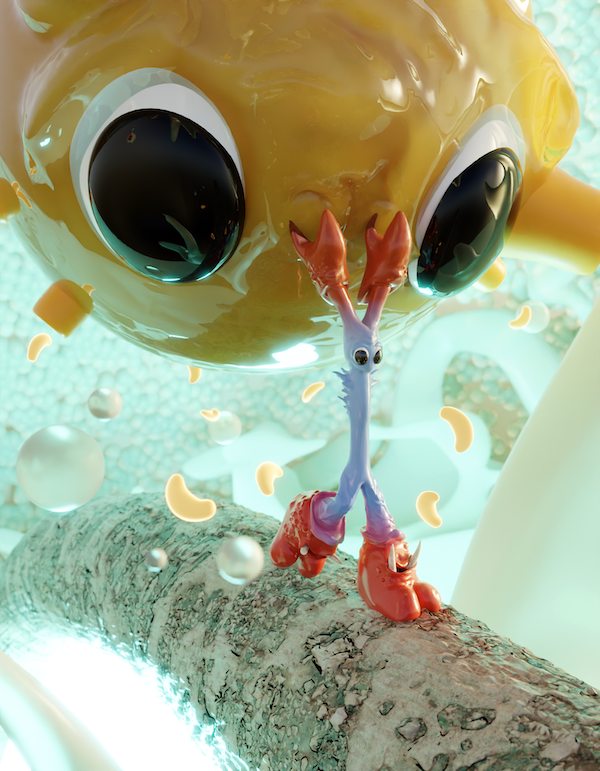 Kinesin carrying a mitochondria (2022). 3D illustration made in Blender, by Diego Araujo.
Kinesin carrying a mitochondria (2022). 3D illustration made in Blender, by Diego Araujo.
What materials do you use to create your artworks?
I work with both digital and analogue media. In the digital world, I am mainly focusing on 3D illustrations, which I create in Blender (blender.org), a free 3D creation software. Sometimes I make 2D illustrations in Procreate or Krita (krita.org) which is a free digital painting software. With analogue media I mostly use watercolour and ink. In some cases, I make line drawings with pencil or ink and digitally paint it in Krita.
Regardless of the medium or technique, there is one thing that I always try to do: sketch, on a piece of paper, be it with ink, watercolour or even colour pencil. Then I use it as a reference for some of my work. Some sketches were even the base for creating major stories that are becoming concrete projects now.
 Dandelion searching for love (2018). Mixed media illustration, watercolour and ink, post-processing in GIMP, by Diego Araujo.
Dandelion searching for love (2018). Mixed media illustration, watercolour and ink, post-processing in GIMP, by Diego Araujo.
Recently I am exploring other tools, such as 3D fractal generators and even AI generated art. With fractal art, I use Mandelbulber (sites.google.com/site/mandelbulber/). In it, I can manipulate the parameters of fractal equations and create stunning visual worlds that I explore as if I was a photographer. I love 3D fractal art because it works like a form of concept art, where I can create odd shapes that can look like something out of a fantasy world. It can be used as an “idea generator” or even a way to create a fantasy landscape. With AI art, I am developing a small project with Wombo Dreams. I didn’t think I was gonna like it, but it became a very interesting tool for storytelling. I am not the one that makes the art, but I feel like a scientist exploring a new world and it is my duty to study and describe it.
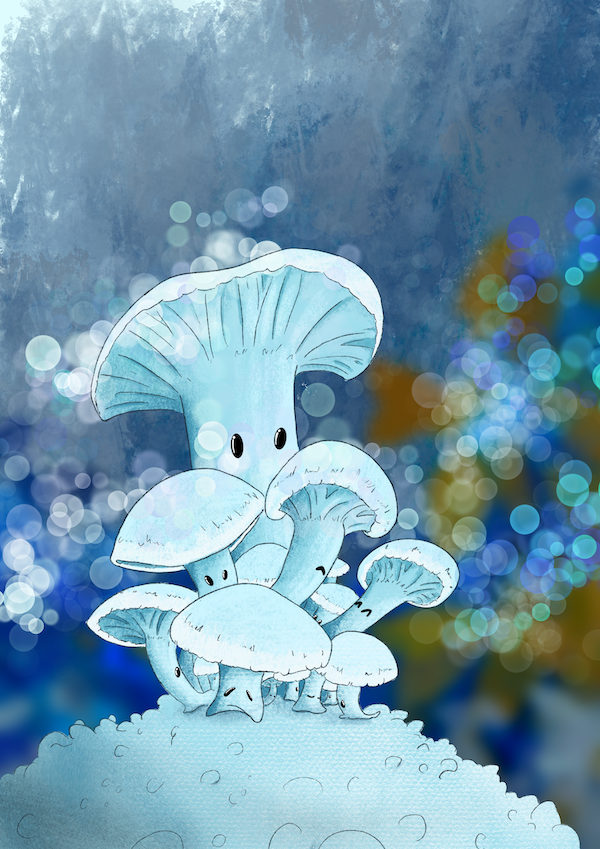 Fungi (2019). Digital illustration made in Procreate, by Diego Araujo.
Fungi (2019). Digital illustration made in Procreate, by Diego Araujo.
One small note. Sorry for the usage of the term analogue media, instead of traditional media. I find if funny to use to word traditional to differentiate digital from physical creations. We have new physical tools that have been developed in the past 5 years, such as the 3D drawing pen, certain types of fluorescent pigments and so on. But because they are not digital, we call them traditional? Meanwhile, we have techniques in 3D modelling and 2D digital painting that are more than 10 years old. Low poly modelling is as old as 3D has existed. Same for pixel art, which was the earliest form of digital art and is coming back as a retro style. So, there are traditional media within digital media too.
 Steampunk Golem (2016). Mixed media illustration, watercolour, acrylics and ink, post-processing in GIMP, by Diego Araujo.
Steampunk Golem (2016). Mixed media illustration, watercolour, acrylics and ink, post-processing in GIMP, by Diego Araujo.
Artwork/Exhibition you are most proud of:
Can I mention two artworks here?!
The first one is the series of three watercolour illustrations that I created in 2016. I was already working as a scientific illustrator, but I was still struggling to create my own personal work. These three pieces represented the moment in which I thought “Oh! I can do it!”. The style was inspired by an artist that I was following on youtube in that time. I followed her process step-by-step, and learned to be patient and to not judge my art when it’s just halfway done. It took me approximately 16 hrs to create each piece (spread over 5-6 days).
I can tell that my current illustration work is different from it, but it evolved from it. My interest in complex detailed scenes started there. Also, the first piece, “Steampunk golem”, was so interesting that I wanted to create a story for it. And this was amazing, because it initiated me in the whole world of storytelling (for writers, and not only for illustrators). I did started writing the story and it changed a lot, but I’ve learned a lot about things like world-building, creating deep characters, the 3-acts structure.
 The caterpillar and the wasp (2022). A scene from the book “Sweet Potato & Walnut”. 3D illustration made in Blender, by Diego Araujo.
The caterpillar and the wasp (2022). A scene from the book “Sweet Potato & Walnut”. 3D illustration made in Blender, by Diego Araujo.
The second one is my book, “Sweet Potato & Walnut – the spiral of life”, which I am almost finishing. It’s an illustrated whimsical story about the biological nature of life and death. It follows the journey of two children into the wilderness. They have several encounters that teach them something about life and death. It’s a project that started with a sketch about 2 years ago, and slowly evolved into a bigger world, which I am building with a lot of influence from ecology, zoology and evolutionary biology. It also helped me find a direction for my personal style both in terms of the ways I want to design characters, creatures and worlds, and also the thematic in my stories. I really want to focus a lot on the idea of how we can understand nature such that we can understand our own nature – to a point of questioning what is life and what is nature.
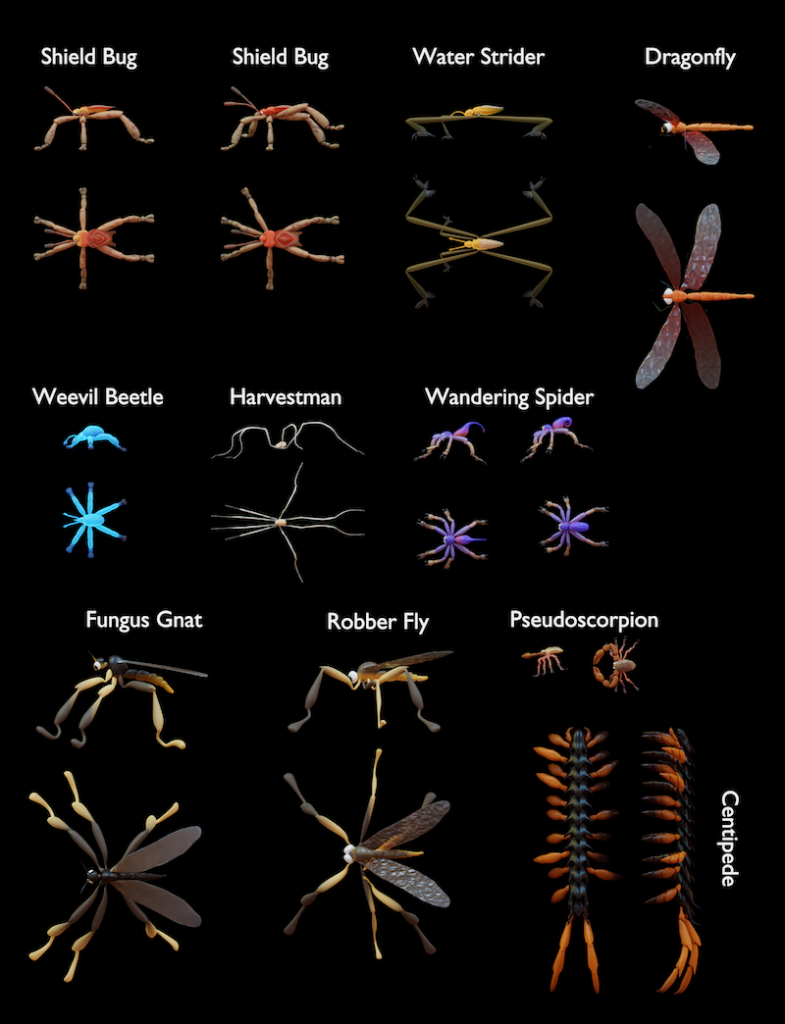 Arthropods (2022). 3D assets for illustrating the story of “Sweet Potato & Walnut”. 3D assets created in Blender, by Diego Araujo.
Arthropods (2022). 3D assets for illustrating the story of “Sweet Potato & Walnut”. 3D assets created in Blender, by Diego Araujo.
Which scientists and/or artists inspire and/or have influenced you?
Let’s start with the scientists. First and foremost, Charles Darwin. It’s not only because of the evolutionary theory and whole body of natural history knowledge that he generated. More than this, it was the kind of scientist he was, which we cannot be nowadays. What in steampunk stories is called “the polymath”, or a person that is well versed in many fields of knowledge. Being a naturalist meant knowing a lot about animals, plants, geography, geology, palaeontology, medicine and maybe even mathematics and engineering (not to forget that some of them also knew painting and drawing). I think I am fortunate to have been exposed to many (yet few) fields of science and then made a switch to art. It’s the closest I can get to the idea of a Victorian naturalist. On this note, I also love the work of Ernst Haeckel.
 The field station (2022). From “The Natural History of the Aetherworld”. AI illustration generated in Disco Diffusion, by Diego Araujo.
The field station (2022). From “The Natural History of the Aetherworld”. AI illustration generated in Disco Diffusion, by Diego Araujo.
For the artists, that’s a bit tricky. The way I am “inspired” nowadays, is very different from what it was 7-8 years ago, when I was starting to make the switch from science to art in my PhD. In those early days, I’ve followed several artists on different online media channels. I would learn a lot of techniques from each one of them. But slowly, I started to follow a principle (or artistic attitude) that I’ve learned from Iain McCaig. It’s about stopping to use the art of other artists as a reference, and start using the world in front of you as a reference. So, in that way, he was a great influence. Because of this, I am being more inspired by the attitudes and approaches than by the art itself. I am heavily influenced by Hayao Miyazaki and Brian Froud. Yes, I love their art, and I hope there is a little bit of their art in my art! But I am mostly influenced by the way they look and interact with nature, and how they bring that to their stories.
 Carnivore plants (2019). Digital illustration made in Procreate, by Diego Araujo.
Carnivore plants (2019). Digital illustration made in Procreate, by Diego Araujo.
SciArt is an emerging term related to combining art and science. How would you define it?
Hmmm… Do this experiment: take the cover illustrations of some scientific journals, and place them in another context, such as a modern art magazine, a fantasy book cover, a product package or even a framed print. Would you (or other people) be able to tell that it is SciArt? It’s just the context that defines it. Unless, of course, you are talking about schematic illustrations for scientific papers – the main bulk of my professional work. But even the anatomical drawing of a heart can be used as the cover for a ficton book about a romantic relationship.
The other way round is also true. An artist painting a portrait of a sad person is not doing what would be considered SciArt. But he is accurately representing the anatomy of a human being. Both anatomy and human emotions are subjects of science, and yet, that would be classified just as a portrait or contemporary art. Nevertheless, his painting could be on the cover of a psychology journal, or a physiology journal featuring a paper on lacrimal glands. Again, it’s mostly the context that defines it.
 Viral invasion (2021). 3D illustration made in Blender, by Diego Araujo.
Viral invasion (2021). 3D illustration made in Blender, by Diego Araujo.
As I mentioned in the first question, is there really a difference between them? I am joking a bit, but I also recognize that sometimes, scientific activities are not really that scientific. Meanwhile, some aspects of art are very scientific. For example, a painting with a blue pigment is definetly blue. It emits blue light, and even if you are colour blind, if you take a spectrophotometer (a machine to measure wavelenghts of light), it will detect blue light. That is as objective as Gravity is objective. And what about all the studies on chemistry of pigments that serve to create paints? Or all the geometry studies that are then coded into the software that allow us to 3D model an animal? Science and art have always been talking to each other and making use of each other for a long time.
Now, let me add one more thing. Think about the earliest form of art that humans created, the cave paintings by palaeolithic and neolithic humans. They have always been interpreted as a way in which humans were recording the natural world around them, reporting it to other humans, and trying to understand it. Trying to understand our natural world is the goal of scientific activity. So, basically, art and science came as one. Or you can think of it as the origin of art being a form of data visualization, and only later on, art branched into representing other things, such as feelings and fantasies.
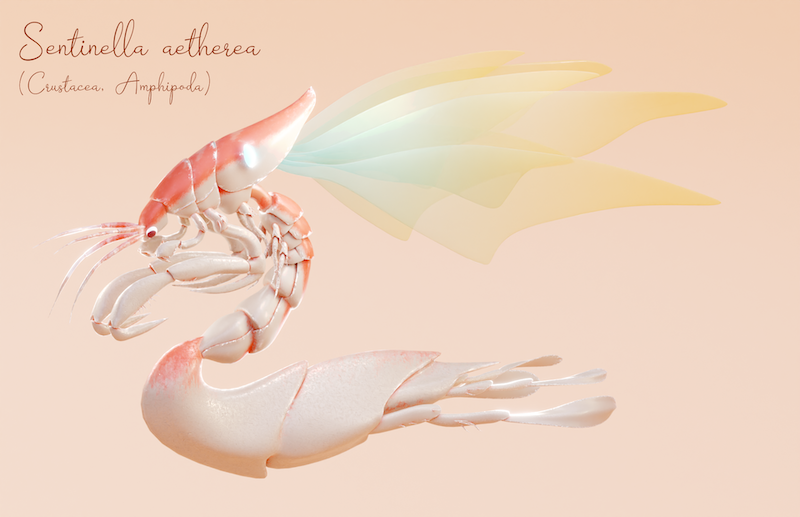 Sentinella aetherea (Crustacea, Amphipoda) (2022). 3D illustration made in Blender, by Diego Araujo.
Sentinella aetherea (Crustacea, Amphipoda) (2022). 3D illustration made in Blender, by Diego Araujo.
Is there anything else you want to tell us?
An advice that I gave to a younger artist: “If you’re gonna be disappointed, be disappointed at your own misconceptions about this career, not about the career itself”.
We are living in an era of massive bombardment of the “follow your dreams” message, but we are ignoring too much the fact that we need to work hard to achieve something, we need to be responsible and accept our choices, and deal with a lot of unwanted tasks. We only want the good without the bad. And I think this desperate need to achieve this kind of dream is leading us to quickly give up on things (or not even trying them). We should dream with our feet on the ground. We should learn more about what goes behind the curtains of science and art, learn that there is the good and the bad in both of them, such that we can deal with it. Both fields have a lot of obstacles in every step of their career paths: school fees are high, school and job entry requirements are high, there is too much competition, low pay (university lecturers can’t even pay university fees for their children), and unstable jobs. Not to mention the human-relation issues, such as sexual harassment, racism and any other form of discrimination and bullying (science can be objective, but it doesn’t mean scientists are… they are human beings after all, not robots). This is not about being negative and giving up. This is about knowing what and where you are getting into, such that you can be more prepared for the problems you may face. Somethings we can change, others we need to swallow. We need to harden ourselves in order to take the hit, fall and be able to stand up in a proper, mature way.
 Cordyceps (2019). Digital illustration made in Procreate, by Diego Araujo.
Cordyceps (2019). Digital illustration made in Procreate, by Diego Araujo.
We are looking at the tip of the mountain and forgetting the path that leads to it. Artist Clint Clearley (https://www.artstation.com/clintcearley) once said that we should learn to live and appreciate the journey, not the destination. And maybe… maybe you can realize that it is ok to get a default job and transform your passion into a hobby. Sometimes, it’s even better. You don’t need to rely on people telling you to change the shape and the colours of a drawing, you can do it your own way and not worry about payment. And some types of sciences, such as taxonomy or biomechanical simulations, you can also do at home, as a hobby. I’ve seem a lot of people (on youtube) building robots and developing technologies at home. Stop trying to define yourself by the degree you have or the animation studio you work in, and start enjoying what you do regardless.
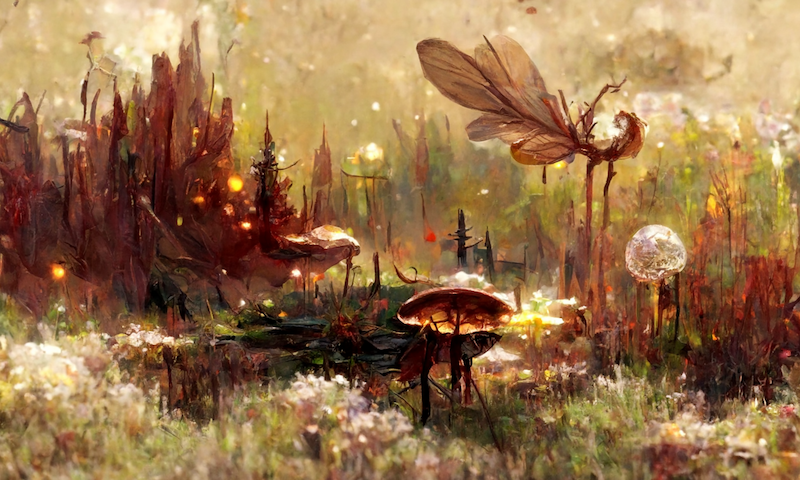 Arriving at the nature reserve (2022). From “The Natural History of the Aetherworld”. AI illustration generated in Disco Diffusion, by Diego Araujo.
Arriving at the nature reserve (2022). From “The Natural History of the Aetherworld”. AI illustration generated in Disco Diffusion, by Diego Araujo.
For more by Diego Araujo, visit his website, Instagram, and ArtStation.
*
Featured image: Dandelion searching for love (2021). 3D illustration made in Blender, by Diego Araujo.
All images courtesy of the artist.
Share this Post
Thank you for reading, please visit Art the Science's Blog for more amazing SciArt content.




